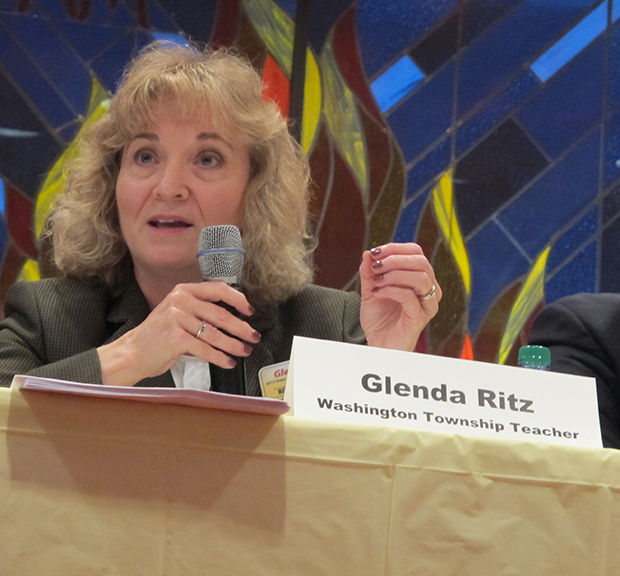As A-F Rewrite Kicks Off, Panel Members Offer Insights On How To Grade Schools

Elle Moxley / StateImpact Indiana
The panel tasked with revising Indiana's A-F accountability system for schools meets for the first time.
The first meeting of the state’s accountability review panel Thursday mostly mapped out the task ahead: designing a new A-F system to grade Indiana schools.
As we wrote yesterday, state laws and federal accountability guidelines will dictate what system Indiana ultimately adopts. Department of Education staffers spent most of the meeting laying out those rules.
But at the end of the meeting, State Superintendent Glenda Ritz led the 17-member panel in a brainstorming exercise that might give us some idea of what to expect from A-F rewrite. She asked members to write down their expectations for “do” and “don’t” as the group moves forward with their work. Here’s what they had to say:
‘Do Recognize The Limitations Of The Assessment’
- “Focus on K-8,” says Derek Redelman, the vice president for education and workforce development policy at the Indiana Chamber of Commerce. Senate President Pro Tem David Long appointed him to the panel. Redelman says he feels the high school growth model, which also incorporates graduation rates and college- and career-readiness indicators, is working for Indiana schools. He’d also like to see the panel design a flexible system that could eventually incorporate growth data from other subjects, such as science and social studies.
- “When we’re looking a model of evaluation, we do need to recognize the limitations of the assessment looking at the growth,” says Melanie Park, a middle school teacher from Huntington, whom Long also appointed. “ISTEP the way it is now is not intended to show growth.” Superintendent Ritz later reiterated Park’s point.
- “It should be a system the public understands,” says Keith Gambill, an Evansville teacher Ritz appointed to the panel. “I think some assume it has to do with school culture or climate of the school. Currently the letter grade doesn’t take into consideration of those factors, but I’m not sure the general public understands that.”
- “There needs to be some mechanism to account for schools with a difficult population,” says Scott Bess, who works for Goodwill Industries of Central Indiana and was appointed by Speaker of the House Brian Bosma. “Some schools are doing tremendous work with a challenging population. We need a way to recognize them. Their highest aspiration shouldn’t be a C.”
- “We really need to make sure schools are held responsible for academic success, regardless of where they come from,” says Sheila Seedhouse, principal of Indianapolis’ Key Learning Community, appointed by Bosma.
- “Take into account the language level of the students,” says Jessica Dunn Feeser, a teacher in Marion County who works with English language learners. Dunn Feeser, another Bosma appointee, says students are sometimes expected to take the ISTEP+ just weeks after they start school in Indiana. “Language acquisition takes time.”
‘Don’t Completely Start Over.’
- “Don’t use school configurations as the basis for determining grades,” says Ritz, who says the current model, which uses different metrics to calculate grades for K-8 schools than 9-12 schools, doesn’t do a great job for accounting for schools that don’t fit neatly into one category.
- “Don’t completely start over,” says Brownsburg Community Schools superintendent Jim Snapp, who was appointed by Governor Mike Pence. “Don’t waste too much time.” Snapp added that the State Board of Education needs to take the work of the panel seriously, and not make wholesale changes to its recommendations.
- “Don’t use only one data point,” says Seedhouse, a point reiterated by Bess. “Don’t make how grades are calculated a moving target.”
- “Don’t have a punitive model,” says Stonybrook Intermediate School principal Robert Lugo, who was appointed by the governor. He says the current system can penalize schools whose students are already high-achieving. “If you achieve a lot, you may not have room to grow.”
- “Don’t throw out high school model,” says Redelman, who earlier said the multiple measures used to grade 9-12 schools are working. “Don’t forget about high performers, they need to be growing as well.”
- “Not all schools have a fair stake in offering science and social studies,” says Indianapolis teacher Casandra McLeod, another Pence appointee. “Don’t add subjects” to the scores used to calculate growth.
The panel isn’t the only state agency working to rewrite the A-F rules. Their recommendations go to the State Board of Education, which will ultimately make the decision on how to grade Indiana schools.

